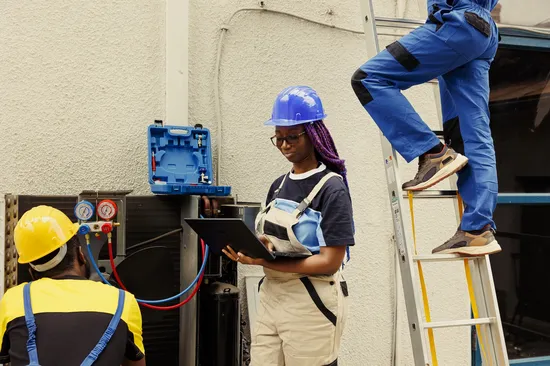Technology adoption can feel daunting no matter what field you work in, yet staying competitive involves embracing tools that drive efficiency, profitability, and better customer experiences. Although some resist new tech because of cost, training hurdles, or fear of change, industry veterans have shown that smart implementation can transform an HVAC business.
In this article, we’ll break down insights from HVAC pros who have successfully adopted technology, highlighting why it matters, how to train teams, and how to separate tech myths from reality.
Staying Competitive Through Learning
Bill Spohn, the founder of TruTech Tools, has spent decades watching the industry evolve. His takeaway? Learning and adapting are the only ways to stay ahead.
"I've worked on products that take good technology and make them accessible. The reality is, that technology is here to enable us, not replace us. I’ve been in HVAC for 35 years, and I’ve never been more pleased with how quickly contractors are adopting new tools."
Those who embrace technology gain an edge. The industry is moving faster than ever: "If you don’t jump on board right away, you might get left behind. Before you know it, you don’t know the new refrigerants, you don’t know the new products, and you get lost."
How to Train & Educate Your Team for Tech Adoption
One of the biggest challenges HVAC business owners face is getting their team on board with new technology. No matter what industry we’re in, we often prefer to rely on experience rather than software or digital tools. However, when training is approached correctly, adoption becomes much smoother.
Jason Julian, shared his approach to rolling out new tech:
"When I decided to implement MeasureQuick, my team groaned. ‘Oh great, something else to learn.’ But I took a gradual approach. I sent one person to training, had them test it, then roll it out step by step. Eventually, the team saw fewer call-backs, better diagnostics, and now they wouldn’t work without it."
Greg Kula also shared insights on helping techs adapt:
"It took about a month or two before our techs saw the wins they were getting. But when they looked at their numbers and saw their closing rates improve, they realized it was worth it."
For some teams - the answer may be to introduce the technology gradually. For others, it may look like ripping the bandaid off - but no matter what, it requires letting team members experience the success for themselves.
Common Myths About HVAC Tech & The Truth Behind Them
There are plenty of misconceptions about technology in HVAC. Let’s break down some of the most common myths:
Myth 1: Technology Will Replace HVAC Jobs
Reality:
Tech isn’t replacing skilled labor, it’s enhancing it. As Greg Kula put it:
"You still need to go into attics. Customers aren’t going to fix their HVAC system with ChatGPT. We need technology, but we also need the people who know how to use it."
Myth 2: Tech Slows Down the Process
Reality:
Initially, yes, there’s a learning curve. But in the long run, it speeds up jobs, eliminates guesswork, and improves results.
"Technology allows us to speed up the minutiae, data collection, diagnostics, so we can be more attentive to the customer," said Michael Housh.
Myth 3: Tech is Too Expensive to Implement
Reality:
Yes, there’s an upfront cost, but the return is worth it. Jason Julian explained:
“I give a customer report, and they have even more confidence. And they're telling their neighbors, ‘hey, you just got a new system. What does your report say?’ to which the response is ‘What do you mean report?’.”
Julian Heat & Air has quickly become a leader in its market - by doing things differently and providing a top tier service for their customer.
Technology doesn’t have to be a burden, it’s an investment that pays off when used correctly.
How to Choose the Right Tools Without Overcomplicating Your Process
With so many software and tools available, how do you pick the right ones without overwhelming your team?
1. Identify Your Biggest Pain Points
- Are call-backs eating into your profits?
- Is training new hires slowing you down?
- Are you struggling to size systems correctly?
Choose technology that directly solves your core problems rather than just adding complexity.
2. Keep it Simple
Bill Spohn emphasized the importance of user-friendly tools:
"Make sure the technology is maintainable and usable. If it’s too complex, your team won’t use it. Pick tools that integrate easily into your workflow."
3. Get Buy-In From Your Team
Greg Kula’s advice? Show them the numbers:
"When techs saw how much better they were performing with MeasureQuick and Conduit, they were all in. You’ve got to show the ‘why’—not just tell them to do it."
4. Work With Vendors Who Offer Support
Unlike traditional suppliers, many new tech companies provide ongoing training and support. Jason Julian shared his experience:
"I can call up the MeasureQuick team or Shelby at Conduit and get answers. You don’t get that from suppliers. The right tech partners make a huge difference."
Technology is an Advantage, Not a Threat
If there’s one lesson from HVAC veterans, it’s this: Don’t fear technology, leverage it.
- Adopting tech improves efficiency and profitability.
- Training teams properly leads to long-term success.
- The right tools streamline, not overcomplicate, your workflow.
For HVAC pros who want to remain competitive, the choice is clear. Adopt the right tools, train your team, and watch your business grow.
Conduit Tech provides advanced software for load calculations, helping you transform your HVAC business and stand out from your competition.
